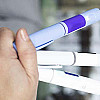Got a hangnail? Here's what to do
- Reviewed by Rebecca Gaffney, MD, Editorial Advisory Board Member, Harvard Health Publishing

Hangnails are small, but they can be surprisingly annoying and even painful. They often appear when the skin around your nails becomes dry, cracked, or damaged. While most hangnails are harmless and can be treated at home, they can sometimes lead to infections if not properly cared for.
What is a hangnail?
A hangnail is a small, torn piece of skin that appears at the edge of a fingernail. Despite its name, a hangnail isn't part of the nail itself but instead a sliver of skin that can peel away from the nail's edge. Hangnails are common and can be painful, especially if they snag on something or get infected.
Why do hangnails happen?
Hangnails often form when the skin around your nails becomes dry and damaged. Common causes include cold weather, frequent hand washing, or exposure to harsh chemicals. People who bite their nails or pick at their skin may also be more likely to get hangnails. Hangnails can also happen if you have brittle nails or if your hands are in water a lot, as they might be when washing dishes.
Treating hangnails at home
Hangnails can often be managed simply at home. Here's how:
- Soak your fingers. Start by soaking your fingers in warm, soapy water for about 10 minutes to soften the skin.
- Trim carefully. Using sanitized nail clippers or small scissors, gently trim the hangnail close to the skin. You might be tempted to pull out the raised piece of skin, but that's something you should avoid. Tearing the skin can cause further damage at the base and increase your risk of developing an infection in the cuticle.
- Apply moisturizer. Use a fragrance-free moisturizing cream or a bit of petroleum jelly to keep the skin around your nails moisturized. Another option is to use a small amount of over-the-counter antibacterial ointment such as bacitracin.
- Bandage if needed. If the area is sore or bleeding, cover with a bandage to protect it from infection until it heals.
How to prevent hangnails
The best way to prevent hangnails is to keep the skin around your nails healthy and hydrated. These skin and nail care tips can help:
- Maintain clean, dry, and hydrated skin. Wash your hands and feet with gentle cleansers, ensuring they are thoroughly dried afterward. Use moisturizers daily and reapply them after each time you wash your hands. Use a fragrance-free hand cream or cuticle oil to keep your skin soft.
- Don't bite your nails. Biting your nails or picking at the skin around them can lead to tears and infection. Instead, trim your nails carefully with a clean tool and avoid cutting your cuticles.
- Protect your hands by wearing gloves. For activities like dishwashing, layer cotton gloves beneath waterproof gloves, such as vinyl ones. Use protective gloves while cleaning, gardening, or spending time outdoors in cold weather.
- Prioritize nail care. Trim your nails straight across using sharp nail clippers or scissors. Use an emery board to slightly round the tips and smooth out any rough edges or snags. Avoid using your nails as tools — for example, don't use a nail to pry open a soda can.
When to see a doctor for a hangnail
Most hangnails heal on their own with home care. However, when the protective barrier of skin around the nail is damaged, it can let in bacteria that can cause an infection. This is known as acute paronychia. Signs of infection include:
- Redness: The skin around the nail becomes red and inflamed.
- Swelling: The affected area may appear puffy or swollen.
- Pain or tenderness: The area around the nail may feel sore or painful, especially when touched.
- Warmth: The infected skin may feel warm to the touch.
- Pus: A pocket of yellow or white fluid (pus) may form near the nail if the infection progresses.
If you notice these symptoms, it's a good idea to seek medical attention, especially if the infection doesn't improve or worsens. Infected hangnails can be painful. And left untreated, the infection can spread to other parts of your finger.
About the Author

Jennifer Fisher, MMSc, PA-C, Health Writer
About the Reviewer

Rebecca Gaffney, MD, Editorial Advisory Board Member, Harvard Health Publishing
Disclaimer:
As a service to our readers, Harvard Health Publishing provides access to our library of archived content. Please note the date of last review or update on all articles.
No content on this site, regardless of date, should ever be used as a substitute for direct medical advice from your doctor or other qualified clinician.











.jpg)



